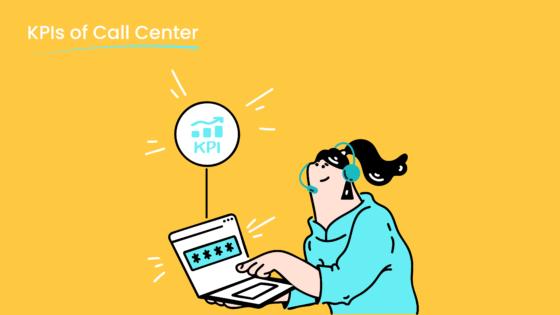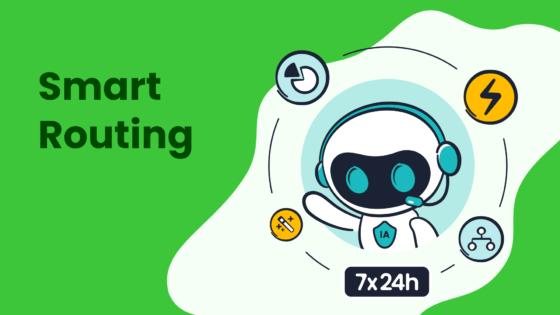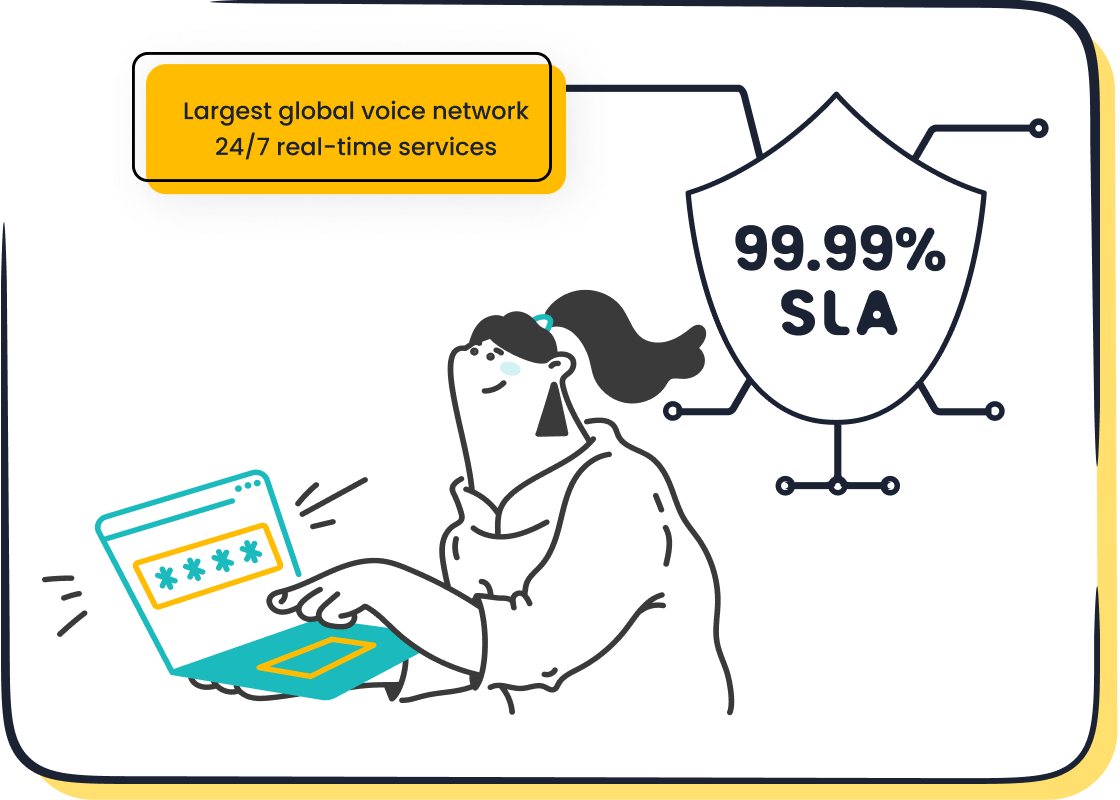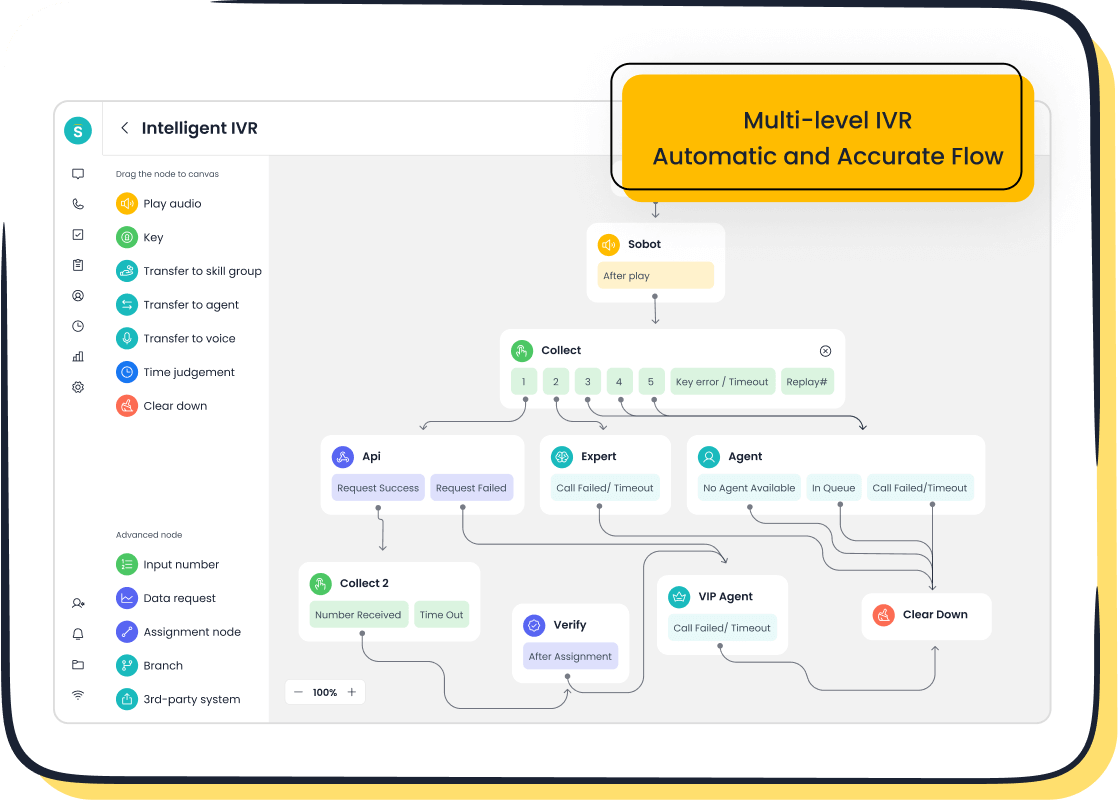10 Strategies to Reduce Average Cost per Call in 2025

Reducing the average cost per call (ACC) has become a critical focus for call centers in 2025. Companies adopting cost-cutting strategies can achieve significant savings, with outsourcing alone reducing expenses by 30-40%. Modern technologies like AI and cloud-based solutions further enhance efficiency, cutting call center costs by up to 27%. These advancements not only lower costs but also maintain service quality by optimizing call routing and enabling remote work models.

Sobot, a leader in intelligent contact center operations, offers innovative tools to help businesses boost efficiency. Its solutions, such as AI-powered Voicebots and cloud-based call centers, empower organizations to streamline processes and achieve sustainable cost management strategies. By leveraging Sobot’s expertise, businesses can unlock savings while ensuring exceptional customer experiences.
Leverage AI-Powered Solutions for Cost Reduction
Automate Routine Customer Interactions
Use AI-powered Voicebot for handling FAQs and repetitive inquiries.
AI-powered Voicebots have revolutionized how call centers handle routine inquiries. These intelligent systems can manage up to 80% of repetitive tasks, such as answering FAQs, without human intervention. By automating routine tasks, you can significantly reduce the cost per call while maintaining high service quality. For example, the cost of automated self-service interactions is as low as $0.10 per interaction compared to $8.00 for live agent calls. This translates to substantial savings for your business.

Sobot’s AI-powered Voicebot offers advanced intent recognition, enabling it to resolve customer issues quickly and accurately. It also integrates seamlessly with your existing systems, ensuring a smooth transition to automation. By adopting this technology, you can improve operational efficiency and free up agents to focus on more complex customer needs.
Reduce agent workload and improve operational efficiency.
Automating routine tasks not only reduces costs but also lightens the workload for your agents. With fewer repetitive inquiries to handle, your team can dedicate more time to resolving complex issues, leading to higher customer satisfaction. Predictive analytics, another AI-driven tool, enhances service levels by 30%, ensuring that your call center operates at peak efficiency.
The benefits extend beyond cost reduction. Sobot’s solutions, for instance, help you streamline workflows and monitor performance in real-time. This approach not only reduces the cost per call but also boosts overall productivity, making it a win-win for your business.
Enhance Self-Service Options
Implement intelligent IVR systems for customer self-service.
Intelligent IVR systems are a game-changer for call centers aiming to implement self-service options. These systems allow customers to resolve issues independently, reducing the need for live agent intervention. For instance, automating 30% of calls in a 100,000-call/month center can save $150,000 annually at a $5 cost-per-call rate. Additionally, improving IVR containment rates by just 5% can cut call center costs by up to 30%.
Sobot’s intelligent IVR system offers features like voice recognition and intent identification, enabling faster resolutions. By implementing self-service options, you can shorten queues, enhance customer satisfaction, and reduce cost per call effectively.
Minimize the need for live agent intervention.
Self-service options not only save money but also improve the customer experience. When customers can resolve their issues quickly through an IVR system, they are less likely to experience frustration. Increasing self-service resolution rates by 15% can lead to fewer agent-assisted calls and shorter wait times.
Sobot’s IVR technology empowers your customers to find solutions independently while ensuring that complex issues are escalated to the right agent. This balance between automation and human intervention helps you achieve cost reduction strategies without compromising service quality.

Optimize Call Routing and Workforce Management
Intelligent Call Routing
Use Sobot's Smart Call Routing to match customers with the best-suited agents.

Matching customers with the right agents is essential to optimize call routing and improve service efficiency. Sobot’s Smart Call Routing uses advanced algorithms to connect customers with agents who have the skills and expertise to address their specific needs. This approach reduces the time spent transferring calls between agents, which directly lowers call center costs. For example, businesses using intelligent routing have reported a 20% improvement in operational efficiency.
By leveraging Sobot’s solution, you can ensure that customers receive prompt and accurate assistance. This not only enhances their experience but also helps improve first call resolution rates. When issues are resolved on the first attempt, it reduces repeat calls and boosts customer satisfaction.
Reduce call handling time and improve first-call resolution rates.
Reducing call handling time is a critical factor in lowering call center costs. Sobot’s Smart Call Routing minimizes delays by directing calls to the most suitable agent immediately. This reduces the average handle time and ensures faster resolutions. Studies show that improving first call resolution rates by just 10% can cut operational costs by up to 15%.
With Sobot’s tools, you can streamline call processes and achieve higher efficiency. This not only saves money but also strengthens customer loyalty by delivering quick and effective solutions.
Workforce Scheduling Tools
Predict call volumes to avoid overstaffing or understaffing.
Accurate workforce planning is vital to optimize workforce management and control call center costs. Workforce scheduling tools analyze historical data and real-time call volumes to predict traffic patterns. This ensures that you have the right number of agents available at all times.
| Evidence Description | Impact on Staffing |
|---|---|
| Scheduling tools predict call traffic patterns and peak hours. | Minimizes wait times and ensures prompt assistance. |
| Tools analyze historical data and real-time call volume to generate optimized schedules. | Aligns staffing with customer demand. |
| Efficient allocation of resources based on predicted call volume. | Ensures adequate coverage during peak hours. |
| Maintaining proper agent coverage throughout the day. | Avoids understaffing and overstaffing. |
Sobot’s workforce management solutions help you align staffing with customer demand, ensuring smooth operations and cost efficiency.
Monitor agent performance to identify training needs.
Monitoring agent performance is another key aspect of workforce management. By tracking metrics like average handle time and resolution rates, you can identify areas where agents may need additional training. This proactive approach improves service quality and reduces errors, which can otherwise increase call center costs.
Sobot’s monitoring tools provide real-time insights into agent performance. These insights allow you to address skill gaps and enhance overall productivity. With better-trained agents, you can optimize workforce management and deliver exceptional customer service.
Invest in Cloud-Based Call Center Solutions
Reduce Infrastructure Costs
Migrate to Sobot's Cloud Call Center for scalable and cost-effective operations.
Migrating to a cloud-based call center solution can significantly lower your operational expenses. Traditional on-premises systems often require substantial investments in hardware, maintenance, and IT staff. By switching to Sobot's Cloud Call Center, you can eliminate these costs while enjoying a scalable and reliable platform. For example, businesses transitioning from on-premises systems to cloud solutions report an average cost savings of 7% on IT staff expenses and 14% on maintenance costs.
| Cost Area | Percentage Reduction |
|---|---|
| Maintenance Costs | 7% |
| IT Staff Costs | 14% |

Sobot’s cloud-based technology offers a 99.99% uptime, ensuring uninterrupted service. Its global network and seamless integration capabilities make it an ideal choice for businesses looking to reduce call center costs while maintaining high performance. This approach not only reduces infrastructure expenses but also enhances operational efficiency.
Eliminate expenses associated with on-premises systems.
On-premises systems come with hidden costs, including physical space, utilities, and equipment upgrades. Migrating to a cloud-based solution eliminates these expenses entirely. For instance, a 500-seat call center can achieve up to a 43% reduction in infrastructure costs by adopting cloud technology.
| Call Center Size | Percentage Reduction in Costs |
|---|---|
| 100 seats | 23% |
| 250 seats | 34% |
| 500 seats | 43% |
By leveraging cloud-based technology, you can focus your resources on improving customer service rather than maintaining outdated systems. This shift allows you to achieve sustainable cost reduction while enhancing your call center's capabilities.
Enable Remote Work
Support remote agents to lower overhead costs.
Remote work has become a game-changer for call centers aiming to reduce overhead costs. By enabling remote operations, you can eliminate expenses related to office space, utilities, and equipment maintenance. Companies adopting remote work save approximately $11,000 per employee annually. Additionally, call center costs can decrease by 27% through the elimination of physical office-related expenses.
- Remote operations eliminate the need for physical office space and associated costs.
- Companies save $11,000 per employee annually by adopting remote work.
- Call center costs drop by 27% when physical office expenses are removed.
Sobot’s cloud-based call center solutions support remote agents seamlessly, ensuring they have access to the same tools and data as in-office staff. This flexibility not only reduces costs but also improves agent satisfaction and productivity.
Access a global talent pool for staffing flexibility.
Remote work allows you to hire agents from a broader geographic area, giving you access to a global talent pool. This flexibility makes it easier to manage seasonal demand peaks and ensures you have the right staff available at all times. Over 70% of employees report feeling more productive when working from home, which translates to better service quality for your customers.
Remote setups also enable you to scale operations quickly to meet fluctuating demands. Sobot’s cloud-based platform ensures that your remote agents can operate efficiently, providing consistent service regardless of their location. This approach not only enhances staffing flexibility but also helps reduce call center costs effectively.
Streamline Call Processes and Scripts
Standardize Call Handling Procedures
Use Sobot's Unified Workspace to ensure consistent service quality.
Standardizing call handling procedures is essential for maintaining consistent service quality across your call center. Without a unified approach, agents may handle calls differently, leading to inefficiencies and inconsistent customer experiences. Lean principles emphasize the importance of standardization to ensure predictable outcomes and high-quality service.

Sobot’s Unified Workspace simplifies this process by providing agents with a centralized platform to manage calls and customer information. This tool ensures that every agent follows the same procedures, reducing variability and improving efficiency. Metrics like Average Speed of Answer (ASA), Quality Assurance (QA) scores, and First Contact Resolution (FCR) demonstrate the impact of standardization:
| Metric | Description |
|---|---|
| Average Speed of Answer (ASA) | Measures the average time taken for a call to be answered, indicating responsiveness and service quality. |
| Quality Assurance (QA) scores | Evaluates customer interactions against standards, ensuring consistent service quality and identifying training needs. |
| First Contact Resolution (FCR) | Tracks the percentage of issues resolved on the first contact, indicating effective service and enhancing satisfaction. |
By leveraging Sobot’s tools, you can achieve measurable improvements in these areas, leading to better customer experiences and significant savings.
Reduce variability in call duration across agents.
Variability in call duration often stems from inconsistent handling procedures. Standardized processes help reduce this variability, ensuring that all agents deliver efficient and predictable service. When agents follow a unified approach, your call center can operate more smoothly and reduce unnecessary costs.
Sobot’s Unified Workspace supports this goal by equipping agents with the resources they need to handle calls consistently. This approach not only improves operational efficiency but also enhances customer satisfaction. By reducing variability, you can lower call center costs and achieve greater savings.
- Standardized processes reduce inefficiencies caused by inconsistent handling.
- Lean principles advocate for uniformity to ensure consistent performance.
- Sobot’s tools streamline workflows, helping agents deliver predictable results.
Dynamic Call Scripts
Adapt scripts based on customer needs for personalization.
Personalized service is a key factor in improving customer satisfaction. Dynamic call scripts allow agents to tailor their responses based on the specific needs of each customer. This approach not only enhances the customer experience but also reduces call handling time by providing agents with relevant prompts and solutions.
Sobot’s Unified Workspace integrates dynamic scripting capabilities, enabling agents to adapt their conversations in real-time. For example, if a customer calls about a billing issue, the script can guide the agent through the resolution process step-by-step. This level of personalization ensures that customers feel valued while helping your call center achieve higher efficiency.
Improve efficiency and customer satisfaction.
Dynamic call scripts streamline the call process by providing agents with clear and concise instructions. This reduces the likelihood of errors and ensures that calls are handled quickly and effectively. Studies show that personalized interactions can increase customer satisfaction by up to 20%, making it a worthwhile investment for your call center.
Sobot’s solutions empower agents to deliver personalized service without sacrificing efficiency. By implementing dynamic scripts, you can improve first-call resolution rates, reduce call center costs, and achieve long-term savings.
Monitor and Analyze Performance Metrics
Identify Bottlenecks in Call Processes
Use Sobot's Monitoring and Analysis tools to pinpoint inefficiencies.
Monitoring performance metrics is essential for identifying inefficiencies in your call center. Metrics like first call resolution (FCR), average handle time (AHT), and customer satisfaction scores (CSAT) reveal areas where processes may falter. For example, high call transfer rates or recurring customer complaints often indicate bottlenecks that need immediate attention.

Sobot's Monitoring and Analysis tools provide real-time insights into these metrics, helping you pinpoint inefficiencies quickly. By using data analytics, you can identify excessive expenses and streamline workflows. This approach not only reduces call center costs but also improves service quality.
| Indicator | Description |
|---|---|
| First call resolution (FCR) | Measures the percentage of customer issues resolved during initial contact. |
| Average handle time (AHT) | Tracks the total duration of customer interactions from start to finish. |
| Customer satisfaction score (CSAT) | Measures customer perception of service quality through post-interaction surveys. |
| Net promoter score (NPS) | Indicates customer loyalty and their likelihood to recommend services. |
| Customer effort score (CES) | Measures how easy customers find it to resolve their issues. |
By leveraging these insights, you can implement targeted solutions to streamline workflows and reduce cost per call effectively.
Implement targeted solutions to streamline workflows.
Once you identify bottlenecks, addressing them with targeted solutions becomes crucial. For instance, if FCR rates are low, investing in training and development for agents can improve their problem-solving skills. Similarly, if AHT is high, optimizing call scripts or enhancing self-service options can lead to faster resolutions.
Sobot's tools enable you to use data analytics to monitor agent performance trends and identify areas for improvement. Regularly reviewing performance data ensures that your call center operates efficiently, leading to significant savings and better customer experiences.
Reduce Average Handle Time (AHT)
Empower agents with real-time support tools.
Equipping agents with real-time support tools can significantly reduce AHT. These tools provide instant access to customer information, enabling agents to resolve issues faster. For example, timely feedback helps agents adjust their approach during calls, improving efficiency and customer satisfaction.
Sobot's Unified Workspace offers a centralized platform where agents can access all necessary data during interactions. This reduces the time spent searching for information and allows agents to focus on delivering solutions. By using these tools, you can lower AHT and achieve cost reduction while maintaining high service quality.
- Real-time tools enhance evaluations and reduce AHT.
- Timely feedback improves agent performance and efficiency.
- Regular feedback supports skill development and targeted training.
Optimize call handling to lower costs.
Optimizing call handling processes is another effective way to reduce cost per call. Streamlined workflows, dynamic call scripts, and intelligent routing ensure that agents handle calls efficiently. Studies show that reducing AHT by just 10% can lower call center costs by up to 15%.
Sobot's solutions, such as Smart Call Routing and AI-powered Voicebots, help you achieve these optimizations. These tools not only reduce call handling time but also improve first-call resolution rates. By focusing on efficient call handling, you can implement cost management strategies that deliver measurable savings.
Balance Cost Reduction with Customer Satisfaction
Prioritize First-Call Resolution
Focus on resolving issues during the first interaction.
Resolving customer issues during the first interaction is one of the most effective ways to reduce call center costs. When you prioritize first-call resolution, you minimize the need for repeat calls, which directly lowers the cost per call. High-performing call centers use first-call resolution rates to identify training gaps and improve their knowledge bases. This proactive approach not only reduces operational costs but also enhances service quality.
For every 1% improvement in first-call resolution, operating costs decrease by 1%. Additionally, customer satisfaction improves by 1%, and employee satisfaction increases by 2.5%. These benefits highlight the importance of addressing customer concerns effectively during the initial interaction.
| Improvement in FCR | Impact on Costs/Volume |
|---|---|
| 1% | 1% reduction in operating costs |
| 1% | 1% improvement in customer satisfaction |
| 1% | 2.5% improvement in employee satisfaction |
Reduce repeat calls and improve customer loyalty.
First-call resolution also plays a critical role in building customer loyalty. Customers are more likely to remain loyal when their issues are resolved promptly. Data shows that 99% of customers whose issues are resolved on the first call continue doing business with the company, compared to only 85% for those requiring follow-up calls.
| Resolution Method | Customer Loyalty Rate |
|---|---|
| Resolved on First Call | 99% |
| Required Follow-Up Calls | 85% |
By focusing on first-call resolution, you not only reduce call center costs but also strengthen customer relationships. Sobot’s Smart Call Routing and Unified Workspace tools help agents resolve issues efficiently, ensuring a seamless experience for your customers.
Collect and Act on Customer Feedback
Use surveys to identify areas for improvement.
Customer feedback is a valuable resource for identifying areas where your call center can improve. Surveys allow you to gather insights into customer experiences, helping you pinpoint inefficiencies and implement targeted solutions. For example, feedback on long wait times or unresolved issues can guide you in optimizing call processes and reducing the cost per call.
Sobot’s Monitoring and Analysis tools make it easy to collect and analyze customer feedback. These tools provide actionable insights, enabling you to address pain points and enhance service quality. By acting on feedback, you can ensure that your cost-saving measures align with customer expectations.
Ensure cost-saving measures do not compromise service quality.
While reducing call center costs is essential, it should never come at the expense of service quality. Customers value prompt and effective support, and any compromise in service can lead to dissatisfaction and churn. Regularly reviewing feedback ensures that your cost-reduction strategies maintain a balance between efficiency and customer satisfaction.
Sobot’s solutions, such as AI-powered Voicebots and intelligent IVR systems, help you achieve this balance. These tools automate routine tasks while ensuring that complex issues receive the attention they deserve. By leveraging technology and customer insights, you can reduce costs without sacrificing the quality of your service.
Reducing the average cost per call (ACC) in 2025 requires a combination of innovative strategies and advanced tools. By automating routine tasks, optimizing call routing, and adopting cloud-based solutions, you can achieve significant savings. For instance, businesses have reported cost reductions ranging from $2.70 to $5.60 per call by implementing these strategies. Leveraging AI-powered tools and workforce management systems further enhances efficiency while maintaining service quality.
Sobot’s intelligent call center solutions, such as AI-powered Voicebots and cloud-based platforms, empower you to streamline operations and reduce costs effectively. These tools ensure scalability, reliability, and seamless integration, making them ideal for modern call centers. Explore Sobot’s offerings to transform your operations and achieve sustainable cost management.
FAQ
What is the average cost per call, and why does it matter?
The average cost per call (ACC) measures the expense of handling a single customer interaction. It includes agent salaries, technology, and overhead costs. Lowering ACC improves profitability and operational efficiency. For example, reducing ACC by $1 in a 100,000-call/month center saves $100,000 monthly.
How can AI-powered Voicebots reduce call center costs?
AI-powered Voicebots handle repetitive tasks like FAQs, reducing the need for live agents. For instance, automating 80% of routine inquiries can cut costs by up to 30%. Sobot’s AI-powered Voicebot integrates seamlessly, ensuring efficient operations and significant savings.
What are the benefits of using cloud-based call center solutions?
Cloud-based solutions eliminate infrastructure costs, offer scalability, and support remote work. Businesses switching to Sobot’s Cloud Call Center report up to 43% savings on infrastructure expenses. Its 99.99% uptime ensures uninterrupted service, making it a reliable choice for cost reduction.
How does first-call resolution impact customer satisfaction?
First-call resolution (FCR) resolves issues during the initial interaction, reducing repeat calls. A 1% improvement in FCR decreases operating costs by 1% and boosts customer satisfaction by 1%. Sobot’s Smart Call Routing enhances FCR rates, ensuring efficient and satisfying customer experiences.
Why is monitoring performance metrics essential for cost reduction?
Performance metrics like average handle time (AHT) and first-call resolution (FCR) identify inefficiencies. For example, reducing AHT by 10% can lower costs by 15%. Sobot’s Monitoring and Analysis tools provide real-time insights, helping you streamline workflows and cut expenses effectively.
See Also
A Guide to Successfully Implementing Omnichannel Contact Centers
Best Cloud Contact Center Solutions to Consider in 2024
Comprehensive Reviews of Leading Contact Center Solutions 2024
Enhancing Call Center Efficiency Through Effective Monitoring
Essential Practices for Effective Call Center Quality Management
